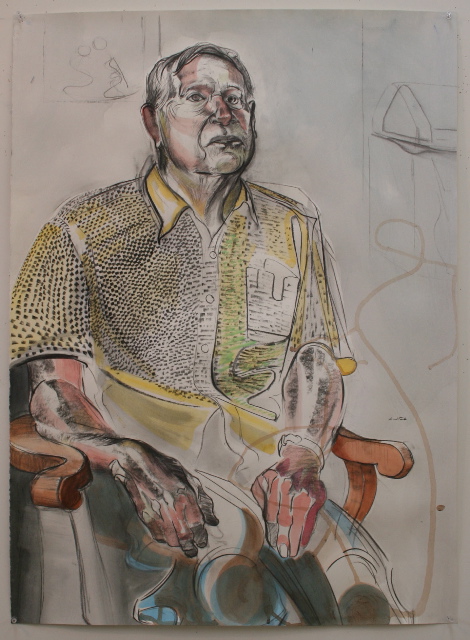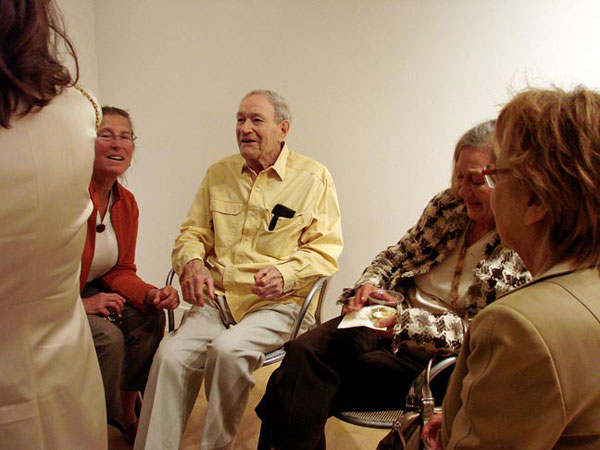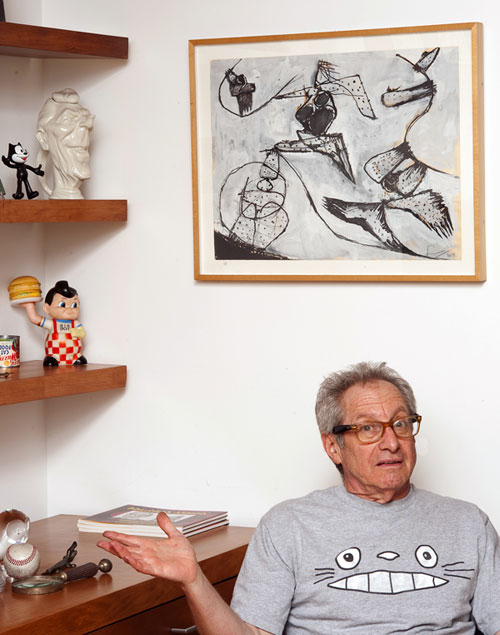
www.davidtomb.com
When David Tomb created his mixed-media portrait of artist Frank Lobdell in 2002, the experience left him wrung out. Working "on the spot" in Lobdell's San Francisco studio Tomb recalls that he was "so nervous, actually, that when I went home my neck went into massive seizure - doctors, painkillers; therapy for several months."
In his effort to create a psychologically accurate portrait of a veteran painter known for his verbal reticence and monastic studio practices, Tomb had taken on a tough subject. Just what is going on, he had to wonder, in the mind of a man whose art is a perplexing mix of the inchoate and the fantastic? Looking at Lobdell's paintings is always bracing; trying to unravel his psyche is apparently exhausting.
With his considerable effort, Tomb got Lobdell right: the strong jaw, the glowering intelligence, the unease at being scrutinized. Lobdell was "very pleased with the result" says Tomb. Of course he was: Frank Lobdell has a high respect for art that comes out of struggle and pain. Robbie Conal, who had Lobdell as his graduate advisor at Stanford in the late 70s says that "Frank would mutter at me, sometimes wearily, sometimes conspiratorially, every time we were together for more than half an hour; 'Nothing worth anything is easy.'"
I also studied with Lobdell -- I was an undergraduate art major around the same time that Robbie Conal was a grad student - and I remember not knowing exactly what to make of Lobdell. He was a man of few words who was hard to get to know. He made a similar impression on my classmate John Littleboy:
"He (Lobdell) was broad and heavy-set and usually had a stubbled two-day growth of beard. He seemed to always have on a polo shirt and dark slacks. He might have been an athlete in his youth though that's just a guess. I took him for independent study so we saw each other infrequently. When we did, speaking seemed to be difficult for him, requiring a big physical effort to articulate his thoughts. I never doubted he wanted to be clearly understood, but that wasn't an easy business."
At the beginning of my semester with Lobdell I had it in my mind to try and copy a 17th century Poussin mythological painting, "Echo and Narcissus." Thinking that it was my duty as a figurative painter to try and copy the work of a French master, I carefully sketched in the figures on a grid and had been at work for days before I found Lobdell standing beside my palette table. "Why" he asked, "would you want to paint that?" That was all he had to say, and I remember thinking "That is one great question."
I had never seen any of Frank's paintings, and a bit later in the term I dropped by his office hour thinking he might have one of his canvasses hung in his office. Lobdell was lost in some paperwork when I got there, so I looked around and waited. On the right hand wall was an early Diebenkorn abstract oil -- it was a terrific painting -- but there were no Lobdells in sight. "This man has a rich history," I began to realize, " that is worth looking into."
After my Poussin copy went into the dumpster I tried an abstract picture, and it quickly turned into a chaotic mess. When Frank stopped by to see what I was painting I complained to him and pointed out all of the areas that I thought were unresolved. He got right to the point: "Find an area of the painting that you like," he told me. "I will be back in an hour." I followed his instructions, and when he returned I located one area of the painting where the paint had accidentally fallen into place in an interesting way. "Hang on to that," Lobdell advised.
One of Lobdell's strengths, I gradually learned, was his ability to break down a canvas, scrutinize small areas and understand how they could add up. Susan Harby, who studied under Lobdell as a graduate student, also noticed this strength:
"He lived and painted a micro and macroscopic life on the canvas of forms playing out a drama or game. He looked at my work for the interaction of the small things that added up to make a good painting. He would stand inches away from the painting's surface investigating the small forms or small brushmarks and discuss how they enlivened the surface. They had to add up to something: something truthful."
In this struggle for artistic veracity Lobdell could work up a temper. He was quiet and kind in class, but in his studio he would cut loose. One Saturday I had a job cleaning up Nathan Oliveira's studio in an old VFW building in Palo Alto. Lobdell, and Keith Boyle, another Stanford art professor, had studios across the hall. I remember hearing a crashing sound from across the hall - "Was that a painting hitting the wall?" I wondered - followed by Lobdell's voice screaming out a string of curses.
Oliveira once told me that he and Frank liked to share some whiskey at the studio from time to time, and one memorable evening they drank half a bottle and realized that the liquor had unlocked their tongues. Nathan turned on a tape recorder to preserve the profound revelations about art that were unfolding, but when he ran the tape a few days later. The results were hilariously disappointing.
"When I make art," Nathan heard his drunken voice intone, "I...(long silence)............"
"YESSSSSS," Lobdell assented solemnly.
Robbie Conal, also remembers spending time in Frank's studio, talking art over a few drinks:
"We're sitting at what might have been a folding card table, whatever's left of a 5th of bourbon between us: I brought it. Ruminating -- deeply -- until Frank growls, 'Let's listen to some Beethoven; the late quartets.'
He gestures me over to the record player. I turn it on and drop the arm on spinning black vinyl.
Frank booms, 'Opus 131 in C# minor!' We listen for maybe 10-12 minutes in silence, he's nodding his head, eyes closed. Then, seemingly from within his reverie he says, 'I know people think my work isn't pretty . . .that it doesn't go with the damn drapes...but when I need something for my soul--not for fucking entertainment, you know?--for my soul...I go to Beethoven! That's what my damn art is about.'"
At the end of the term Lobdell invited my class to visit his studio, an exciting moment. He was genuinely liked, even loved, by his students, and we had passed the hat and bought him a large stainless steel frosting knife that we thought would make a good painting tool. Frank loved the knife - it was the most gigantic palette knife ever - and was visibly touched when he unwrapped it.
At his studio that day, Lobdell gave the single most riveting painting demonstration I have ever seen. Placing a canvas flat on the floor, Jackson Pollock style, he scraped some raw oil paint onto the surface and said approvingly "That's a start." In the studio, it was as if we students had disappeared: he was letting us into the privacy of his creative process.
"Hmm...... (silence).....green...... needs yellow." Each time he laid down some paint, it suggested his next move, and each addition was grudgingly, tentatively applied. At first I remember thinking that Lobdell was intuitive, but as I watched the demonstration unfold it hit me: he was counterintuitive. Every scab of paint demanded a response, but the key was that the response had to be strained and unexpected. Lobdell was a tense painter, and it was the tension of the unexpected that kept him alive to his own work. His demonstration painting, as it began to add up, was simultaneously essay in imperfection and a manifesto of sincerity.
Lobdell was "succinct" says Robbie Conal.
"During a one-on-one meeting with Frank, in his studio, after staring at a big new painting of his together for 20 minutes without saying a word, I asked him a question, 'How do you get those fast black linear brush strokes in exactly the right place every time?'
The answer, 'I paint them slow.'"
Lobdell, who told an interviewer in 1960 that "being anonymous is really the best condition to be able to create" was not showing very widely when I knew him, although I do remember him having a small show of monotypes at Galerie Smith Andersen in Palo Alto. Robbie Conal, who served as a Gallery Director for the College of Notre Dame in Belmont in 1979 had to work on Lobdell to convince him to show his 1961 "Summer Mural," a 20 foot wide phallic abstraction. "I can't quite imagine how I managed to trick him into showing the Big Dick," Conal recalls, "but I somehow talked Frank into unfolding and re-stretching the painting and actually showing it."
I don't remember seeing Lobdell at graduation, and in general I think he tried to avoid social situations, and to some degree his students. "He left me an index card with my grade for the quarter on my glass palette" recalls John Littleboy. " I took by his demeanor that painting wasn't an easy task and whatever I did should be done with sincerity and dedication."
Twenty years later, at the opening of an exhibition of The Anderson Collection at San Francisco MOMA, I saw the first Lobdell painting I had seen in more than two decades. A magnificent late abstraction, it more than held its own among the top flight works by Still, Rothko, Pollock and other postwar abstractionists. I looked for Frank to see if I could congratulate him, but was told that he had missed the opening due to hip replacement surgery.
In June 2003, Lobdell's work popped up again: on the cover of ARTnews magazine. In a feature article titled "The Long Distance Runner" Anneli Rufus wrote this about Lobdell:
"Oblivious to art-world trends, Frank Lobdell has spent more than half a century doing what he wants, constantly reinventing himself and finding new territory to explore."
The re-discovery of Frank Lobdell, my stoic painting teacher had begun and the accolades followed. In his introductory essay for the Book "Frank Lobdell: the Art of Making and Meaning" Bruce Guenther writes that "To encounter a Lobdell painting today is to engage at the highest level in a complex dance between structure and symbolism, form and meaning."
Even more extraordinary than the praise being heaped on Lobdell were the revelations about what he had seen while serving as a GI between 1942 and 1945. In a superb essay also published in "Making and Meaning" Timothy Anglin Burgard recounts Lobdell's experience, in April of 1945, of entering a barn in Gardelegen, Germany where Nazi troops had immolated more than 1,000 concentration camp internees. I now fully understand why Lobdell, like many young American painters of the postwar generation, had chosen abstraction over figuration. When you have seen the un-seeable, painting reality becomes excruciating.
When Willem de Kooning painted his epic "Excavation," an abstracted image of a mass grave, he had only seen news photos of what happened in Germany. Lobdell had seen Hell on earth with his own eyes, and it chilled his soul. When he created his "Dance" series during the Viet Nam era -- inspired by medieval images of the 'Dance of Death' -- Lobdell's darkest memories charged the abstract imagery.
"No one who is involved in one of these wars truly survives" Lobdell once told writer Terry St. John.

Frank Lobdell (center) enjoying a 2008 opening at Hackett Friedman Gallery
Photo: Alan Bamberger, artbusiness.com.
Lobdell, who will be 90 in August, made an appearance at Hackett-Mill Gallery last month, where he attended the opening of "Frank Lobdell: 1948-49," an exhibition of a few choice works he made more than 60 years ago." Jessica Phillips, the Associate Director of the gallery reports that Lobdell "enjoyed seeing the work and speaking with collectors and of course former students." Part of Lobdell's legacy is certainly his influence of generations of art students: he taught at the California School of Fine Arts from 1957 until taking a job at Stanford where he taught until 1991.
"Frank Lobdell was one of my instructors at the San Francisco Art Institute in 1963," says veteran artist Ronald Davis. He influenced my student work before I was in his class, and began doing op art. I remember that he told me that, to paraphrase; 'Sometimes it is not what one puts into a painting, but rather what one leaves out that makes it a compelling picture.'"
Truthfully, part of Lobdell's power as a man - and as an artist - is that he told us so little for so long. It is energizing, and exhausting, to read between the brushstrokes of a man who meant every word and every brushstroke. He struggled over every single one of them.

Photo: Alan Shaffer www.shafferphoto.com
on view at Hackett | Mill
January 7 -April 1, 2011
